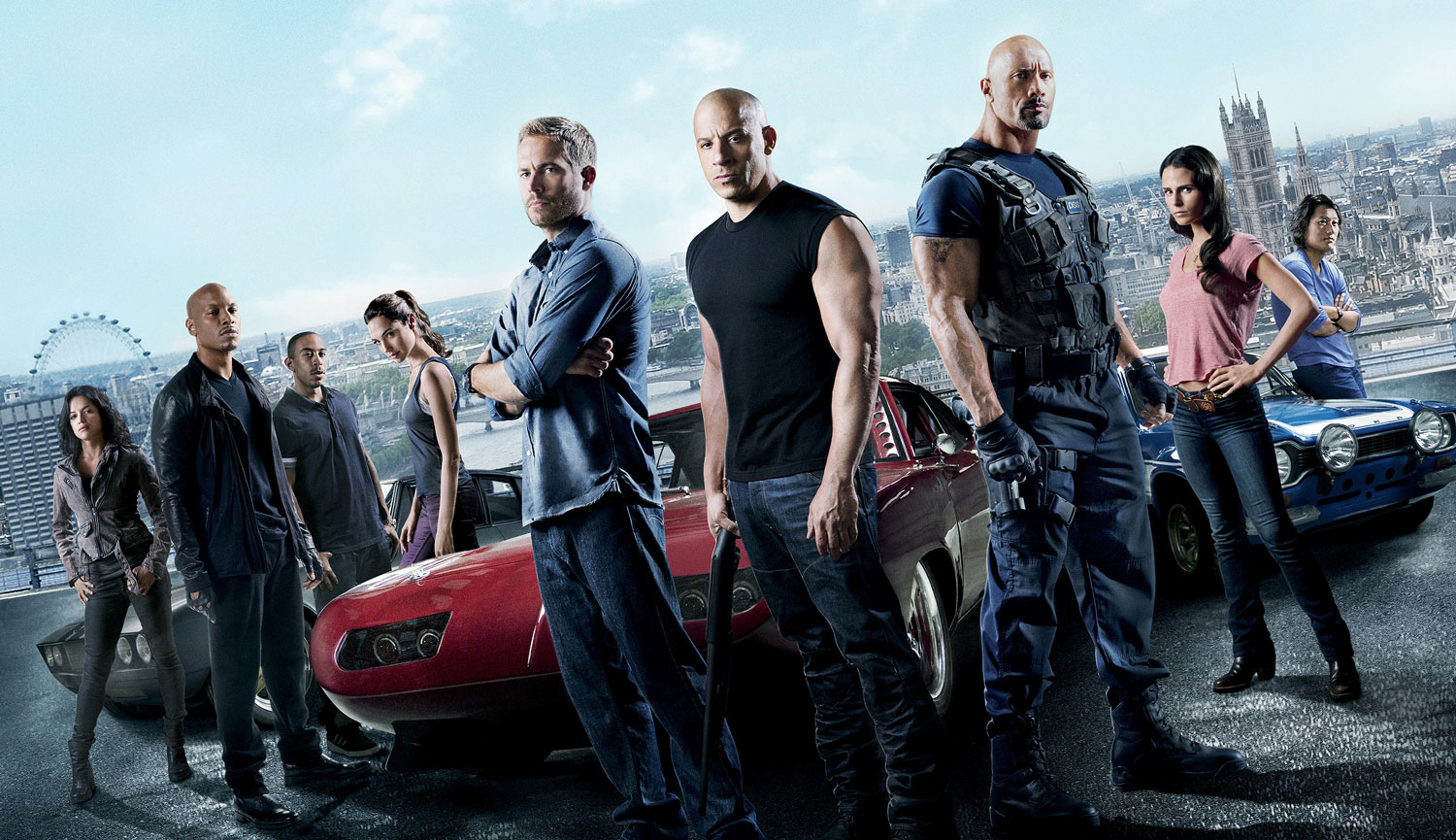Family & Fan Belts: The evolution of the “Fast and Furious” franchise

For characters that live “a quarter mile at a time,” it’s been a long, strange trip for the “Fast and Furious” franchise. Starting in the drag racing scene of downtown L.A., it has since become a global enterprise that has grown with every entry. There’s even talk now that the series may go into space, and the weirdest part is that such a concept isn’t even that strange in the “Fast and Furious” film universe. But it’s important to regard the series as a whole, and with the eighth installment (“The Fate of the Furious“) opening this weekend, now is the perfect time to chart its bizarre evolution from action film knockoff to genuine pop culture phenomenon.
Before going any further, it has to be noted that there’s a clear delineation in the series: the first four movies, and “Fast Five” onward. There’s a clear shift in narrative approach and visualization used in the latter half of the franchise that simply isn’t evident in “The Fast and the Furious” through “Fast & Furious.” But despite that separation (which will be explored below), it’s all part of a (mostly) coherent whole that has its most basic elements in place from the first film. It’s surprising how many of the themes carry through despite the films’ various permutations, but it’s also clear that audiences are dealing with two different beasts when considering the entire series.
The first entry, “The Fast and the Furious,” was released in 2001 and was mostly a success; it did well financially and was generally well-received by audiences. Critics were less interested in the film and most panned it. Perhaps part of the lack of appeal for cinephiles is the fact that this movie is basically a clear rip-off of Kathryn Bigelow’s “Point Break,” replacing surfing with cars. A law enforcement agent goes undercover in a dangerous sport in order to take down a group of criminals but ultimately develops a love interest and man crush among the very people he’s supposed to bring down. It’s almost beat-for-beat the same story, albeit not as successfully or uniquely delivered as Bigelow’s picture. And that’s fine, because in film, great artists pay homage and rework basic concepts all the time to deliver something new and fresh. However, director Rob Cohen and his gaggle of screenwriters were not great artists, so the borrowing became a bit of a slog to those that loved the “source material” of “Point Break.”
But despite its lack of originality and other shortcomings, the germ of a good idea was still in place. There hadn’t been too many films for gearheads and car lovers since the ’70s, the heyday of automotive fetishism with directors like Hal Needham. Car culture had only exploded since that time, expanding with new customizations and mechanical innovations. Plus, there was the idea of the loveable rogue, a cool antihero that played by his own set of rules but nonetheless had a code to follow as embodied by Vin Diesel’s Dominic Toretto character. His lunkhead persona is deepened by his devotion to family and that sense of righteousness he carefully defines within a narrow niche. So the basic setup was created: cars, criminals and outsiders banding together to form something resembling a coherent unit.
The next entry, “2 Fast 2 Furious,” lost Diesel due to production issues but continued with the same basic formula (and Paul Walker as the bland leading man, Brian O’Connor). The greatest legacy of the film, beyond the Tyrese Gibson and Ludacris characters, is that the name is still a go-to mock title for sequels for the lazy and easily entertained who love to put numbers into a fake movie’s name. Next up came “The Fast and the Furious: Tokyo Drift,” which shook things up by not featuring any of the original’s characters (save for a brief cameo by Diesel in the end) but stuck fairly close to the elements of the series and introduced a new one with its exotic locales and sense of globetrotting. Moving from the United States to Japan, director Justin Lin delivered an energetic movie that had a real sense of visual flair and worldbuilding that proved the director understood what was needed to invigorate the series.
The fourth film, “Fast & Furious,” released in 2009, is fairly forgettable but nonetheless an essential bridge component between the first half of the franchise and the second. Justin Lin returned for directing duties, as did all the actors from the first film. The core concepts are all present, but this time with more traveling the world, an emphasis on the importance of family and pushing the boundaries of logic with the cool car stunts. “Fast & Furious” is the awkward teenage stage of the franchise, not quite done with its simplistic roots but not fully embracing its insanity yet. But that would all change with the next installment.
Up until “Fast Five,” the films were moderately successful at the box office and still had its share of fans, although none of them were particularly well-liked by critics (even if “Tokyo Drift” had more supporters than the others). That all changed as the franchise took a hard turn into sheer What-the-Fuckery while doubling down on its own tenets of cars, criminals, family and traversing the globe. “Fast Five” saw Lin envelope all of the previous films into the foundation for his vision of an expansive cinematic universe on par with Marvel, bringing in fan favorite characters from the previous movies and having them work together as high-octane international thieves. This set the new template that would be followed by the next three installments: impossible international shenanigans anchored by likable performances that delivered on inventive set pieces while remaining pure escapist fodder.
“Fast & Furious 6” expands on this comic book influence by pitting the new gang against, essentially, its bizarro selves – evil versions of the genial characters that audiences have grown to love. The “Ocean’s 11″/James Bond feel of “Fast Five” is expanded again to the limits of practicality with even greater stunts and more of an appreciation for family. Audiences (and critics) were again taken by this expansive turn and found a new franchise that wasn’t dependent on pre-existing material, like Marvel or DC, and approached reality like a suggestion. “Furious 7,” directed by James Wan, continued in this vein with Vin Diesel, Dwayne Johnson and Jason Statham all flexing their muscles (sometimes literally) and facing off against each other in impossible situations that boggled the mind with how insane the filmmakers were willing to get with their set pieces.
The closest analogy for the “Fast and Furious” franchise is “Friday the 13th,” and not just because of the number of installments in each series. When people talk about “Friday the 13th,” they picture a hockey-masked Jason killing folks in the woods. However, that’s only true for about half of the movies: he’s not in the first one; in part two, he’s wearing a potato sack instead of a hockey mask; someone named “Roy” impersonates him in the fifth chapter; the majority of “Jason Goes to Hell” doesn’t actually have Jason in it (just a demon thing… it’s a long story); and he’s a cyborg with a metal face in half of “Jason X.”
Similarly, if one were to ask about the “Fast and Furious” series, people would probably talk about an impervious Vin Diesel, either fighting The Rock or dragging a giant vault through the streets of Brazil, or some other insane stunt that sticks a middle finger in the face of physics and auto mechanics everywhere. But that’s not true for most of the series. Nevertheless, that’s what has been embraced by the public as the essence of this franchise, because that’s what is unique, unabashedly silly and utterly entertaining about it. Lin and his screenwriters basically found a way to transform a basic car racing story into the ’80s cartoon “M.A.S.K.” where the only way to steal or fight terrorists is to somehow have a car involved.
It’s been a crazy journey from the dark and dingy streets of L.A. to the heights of an Arabian skyscraper, all fueled by comically enhanced machismo and impossible automobile action. But despite the change from a grittier story based firmly in reality to a brightly lit bit of escapist nonsense that’s wholly entertaining, the same elements have popped up again and again throughout each entry: cars, criminals, family, exotic locales. It may be simplistic to boil it down to those base features, but there have been longer running franchises powered by less (James Bond, for example). By crafting a franchise around these rather basic tenets, the “Fast and Furious” series has been allowed to grow and explore different interpretations through the years, and it will likely continue to change as the needs demand it.
Related Posts
Comments Off on Family & Fan Belts: The evolution of the “Fast and Furious” franchise
Posted in: Entertainment, Movies
Tags: Dwayne Johnson, Fast and Furious, Jason Statham, Michelle Rodriguez, Paul Walker, Vin Diesel








